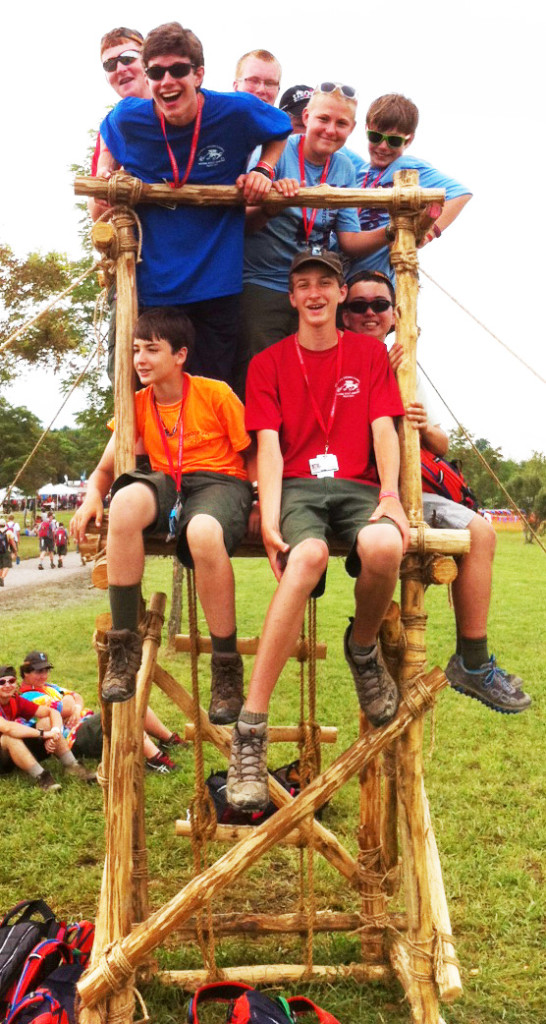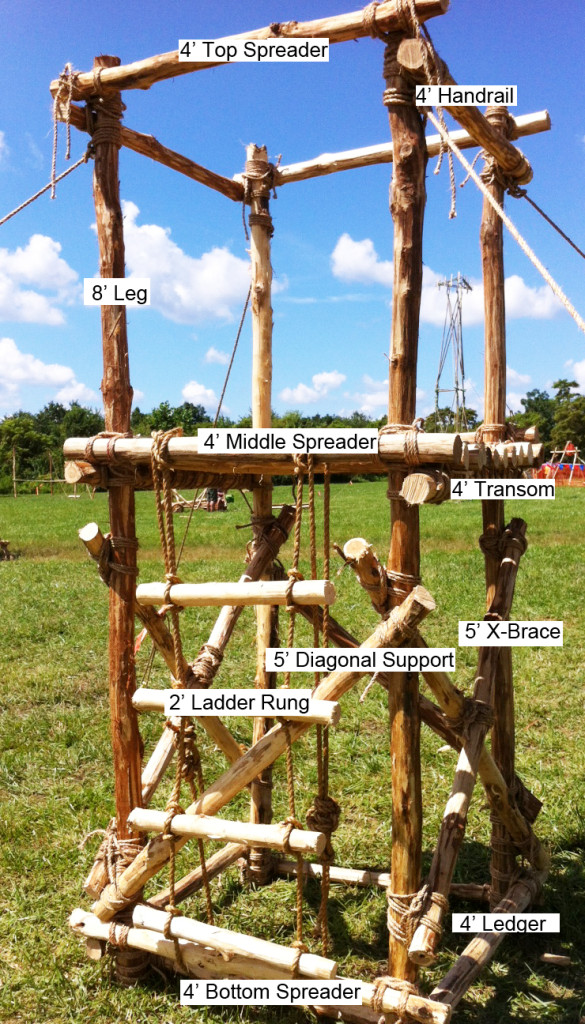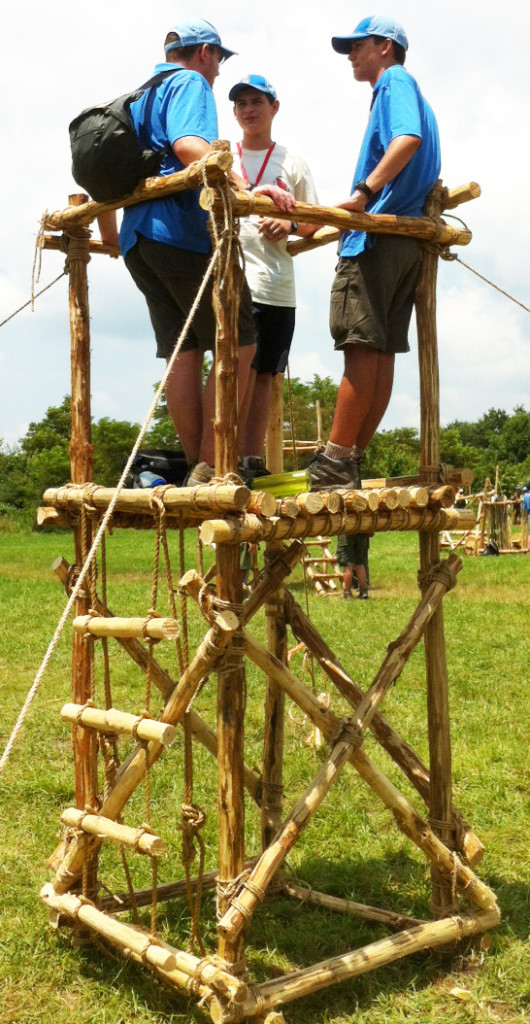 This sturdy climbing tower sees plenty of action wherever it’s built. Its a simple tower design, but very solid. It’s formed by building two trestles with top handrails, and joining them together on each side with three spreaders and a diagonal support. A rope ladder is used to climb up to the platform.
This sturdy climbing tower sees plenty of action wherever it’s built. Its a simple tower design, but very solid. It’s formed by building two trestles with top handrails, and joining them together on each side with three spreaders and a diagonal support. A rope ladder is used to climb up to the platform.
Here are the materials you’ll need:
- four 8-foot x 4-inch spars for the legs
- twelve 4-foot x 3-inch spars for the spreaders
- six 5-foot x 2 to 3-inch spars for the diagonal supports and X-braces
- nine to thirteen 4-foot x 2 to 3-inch floor spars
- four 2-foot x 2-inch ladder rungs
- thirty-eight 20-foot x 1/4-inch lashing ropes
- six 25-foot x 3/8-inch ropes for guylines and ladders
- two 35-foot x 1/4 inch ropes for the floor lashings
- eight pioneering stakes
- four sticks
- binder twine
 Build the Trestles – For each of two trestles, lay two 8-foot spars next to one another on the ground, making sure the butt end of each is on the bottom. With tight square lashings, connect the legs about 3 inches from the bottom with a 4-foot spreader (ledger), and about 6 inches from the top with a 4-foot spreader (handrail). Select one of the stoutest 4-foot spreaders and lash it securely to the legs, so the underside of the spar is 5-feet from the bottom. This leg will serve as the trestle’s transom and act as a platform support for the floor. Make sure the ends of the all the 4-foot spreaders extend out from the legs about 4 inches on each side.
Build the Trestles – For each of two trestles, lay two 8-foot spars next to one another on the ground, making sure the butt end of each is on the bottom. With tight square lashings, connect the legs about 3 inches from the bottom with a 4-foot spreader (ledger), and about 6 inches from the top with a 4-foot spreader (handrail). Select one of the stoutest 4-foot spreaders and lash it securely to the legs, so the underside of the spar is 5-feet from the bottom. This leg will serve as the trestle’s transom and act as a platform support for the floor. Make sure the ends of the all the 4-foot spreaders extend out from the legs about 4 inches on each side.
To add the cross braces (X-braces), lay one end of one of the 5-foot spars on top of one 8-foot leg, about a foot up from the bottom, and place the other end underneath the other 8-foot leg, about a foot down from the 4-foot transom. Lash this 5-foot spar in place with square lashings. Now take a second 5-foot spar, and cross it on top of the first, forming an ‘X’, and lash it in place. Where these cross braces intersect, spring them together with a tight diagonal lashing.
Connect the Trestles – When both trestles are complete, stand them up parallel to one another and join them together by lashing a 4-foot (bottom) spreader tightly on the inside of each trestle’s 4-foot ledger. Also lash a 4-foot top spreader just over the handrails, and a 4-foot middle spreader just over each platform support (trestle transoms).
Tightly lash on a 5-foot diagonal support from the bottom of one leg to just under the X-brace on the other leg.
With all hands on deck, carefully flip over the tower and, in the same fashion, join the trestles on the other side. (When it comes time to lash on the 5-foot diagonal support on the other side, make sure the bottoms of the diagonals are lashed on opposite trestles.) When the trestles are connected on all four sides, with the whole crew pitching in, carefully stand up the tower and place it in position.
 Anchor the Tower – tie one end of a 25-foot rope to each 8-foot leg, 2 feet from the top, using a roundturn with two half hitches. Construct a 1-1 anchor, 12 feet out at 45º from each corner. With rope tackles, secure the guylines to the 1-1 anchors.
Anchor the Tower – tie one end of a 25-foot rope to each 8-foot leg, 2 feet from the top, using a roundturn with two half hitches. Construct a 1-1 anchor, 12 feet out at 45º from each corner. With rope tackles, secure the guylines to the 1-1 anchors.
Lash on the Floor – Lay out the floor spars on top of the platform supports (trestle transoms) and using the 35-foot ropes, lash them securely in place with good floor lashings.
Build and Attach the Rope Ladder – Your rope ladder is made by tying marlin spike hitches to the four 2-foot ladder rungs using the two other 25-foot ropes. Refer to making a rope ladder. Start by tying one end of each rope to the middle spreader on the side of the tower you want the ladder, using a clove hitch or a roundturn with two half hitches. Leave enough tail in the rope so you can tie a bowline with a small loop in the end. Let this bowline dangle down 1 to 2 feet towards the ground.
Space the rungs about 15 inches apart. When all the rungs have been added and are evened out on each side, carry the end of each rope under the 4-foot bottom spreader and thread them through the bowline’s loop. Now tighten each side of the ladder by pulling on the end of each side, using the bowlines’ loops like rope tackles. Finish off with a couple of half hitches. Refer to rope tackle.